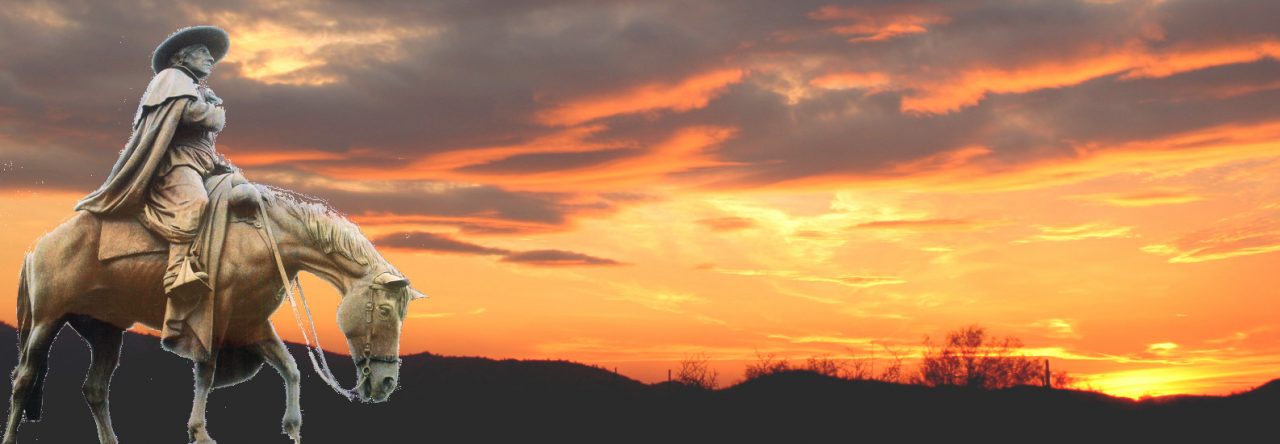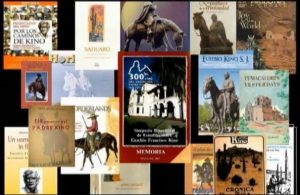Books on Padre Kino Kino on display at “The Tucson Festival of Books”
The third Largest U.S. Book Fair
University of Arizona Campus • March 11 – 12, 2017 • 9:30am to 5:30pm •
Our deepest thanks to the Facebook profile of our friends at “Eusebio Kino” who are proposing selected books related to Padre Kino that will be in display at the “Tucson book Festival”.
Great Books of Kino’s Pimería Alta
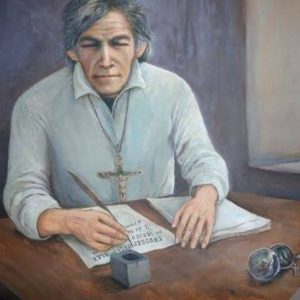 Support the Tucson Festival of Books and the power of literacy. Saturday March 11 and Sunday March 12, 2017. Over 350 books in 5 languages by 315 authors are written about Kino.
Support the Tucson Festival of Books and the power of literacy. Saturday March 11 and Sunday March 12, 2017. Over 350 books in 5 languages by 315 authors are written about Kino.
This Kino painting is one of the Kino series by artist Jose Cirilo Rios Ramos. The Kino series is now on display in Magdalena de Kino on loan from the Museo de Santa Ana, Sonora.
The best Kino writings for the general reader are at:
http://padrekino.com/resources/kino-books-cross-reference/
Tucson Festival of Books website at: http://tucsonfestivalofbooks.org/
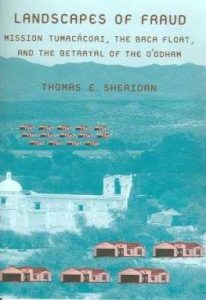 Research anthropologist and historian Dr. Thomas E. Sheridan knows how to tell great stories as he seamlessly weaves groundbreaking scholarship in his many books. In his 2006 book “Landscapes of Fraud, Mission Tumacácori, The Baca Float, and the Betrayal of the O’odham” Tom presents the major themes about Arizona land use and land abuse from prehistory to the modern era and its global context through the microcosm of the Upper Santa Cruz River Valley. His chapters on the O’odham World, Jesuits and Franciscans are a must read for those who seek to understand the interactions between indigenous peoples, missionaries and European colonists.
Research anthropologist and historian Dr. Thomas E. Sheridan knows how to tell great stories as he seamlessly weaves groundbreaking scholarship in his many books. In his 2006 book “Landscapes of Fraud, Mission Tumacácori, The Baca Float, and the Betrayal of the O’odham” Tom presents the major themes about Arizona land use and land abuse from prehistory to the modern era and its global context through the microcosm of the Upper Santa Cruz River Valley. His chapters on the O’odham World, Jesuits and Franciscans are a must read for those who seek to understand the interactions between indigenous peoples, missionaries and European colonists.
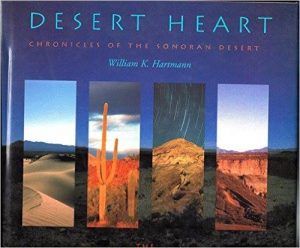 What does planetary scientist Dr. William K. Hartmann and Jesuit missionary Eusebio Kino have in common? Both are famous astronomers, historians and desert rats. Bill Hartmann is the author of scientific books about astronomy and history books about the Spanish Southwest. In his “Desert Heart: Chronicles of the Sonoran Desert,” Bill gives insights about Kino’s life and explorations while describing his own personal journeys in the Pinacate volcanic fields and the Gran Desierto. Bill’s paintings appear in many books including Carl Sagan’s. Below is Bill’s painting of the site of Mission Dolores, Kino’s headquarters for the last 24 years of his life.
What does planetary scientist Dr. William K. Hartmann and Jesuit missionary Eusebio Kino have in common? Both are famous astronomers, historians and desert rats. Bill Hartmann is the author of scientific books about astronomy and history books about the Spanish Southwest. In his “Desert Heart: Chronicles of the Sonoran Desert,” Bill gives insights about Kino’s life and explorations while describing his own personal journeys in the Pinacate volcanic fields and the Gran Desierto. Bill’s paintings appear in many books including Carl Sagan’s. Below is Bill’s painting of the site of Mission Dolores, Kino’s headquarters for the last 24 years of his life.
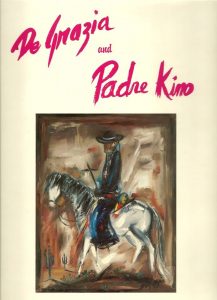 Artist Ted DeGrazia called Kino “a damn good friend” in his book “DeGrazia and Padre Kino” that was published 3 years before his death. The book reproduces the series of DeGrazia’s vibrant oil paintings and pen and ink drawings depicting events in Kino’s life. The paintings are displayed in the first room of the permanent collection at the DeGrazia Gallery in the Sun. “DeGrazia and Padre Kino” also republishes the 55 paged exhibit book from the 1962 Kino-DeGrazia art show that propelled Ted’s career and drew the largest crowds in the history of the Southwest Museum in Los Angeles.
Artist Ted DeGrazia called Kino “a damn good friend” in his book “DeGrazia and Padre Kino” that was published 3 years before his death. The book reproduces the series of DeGrazia’s vibrant oil paintings and pen and ink drawings depicting events in Kino’s life. The paintings are displayed in the first room of the permanent collection at the DeGrazia Gallery in the Sun. “DeGrazia and Padre Kino” also republishes the 55 paged exhibit book from the 1962 Kino-DeGrazia art show that propelled Ted’s career and drew the largest crowds in the history of the Southwest Museum in Los Angeles.
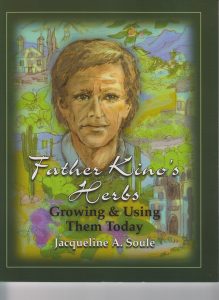 “Father Kino’s Herbs: Growing and Using Them Today” by Dr. Jacqueline Soule engagingly presents herbs that Kino introduced to the Sonoran Desert & the native herbs that he learned about from the O’odham people. Dr. Soule describes how easy it is to grow and cook with these herbs and to use them in other ways like natural beauty products, air fresheners & insect repellents. Kino’s work as a Jesuit missionary included searching for new medicinal plants. The Jesuits’ most important discovery was quinine or Jesuit’s Bark.” Quinine was the most effective drug to treat malaria for 300 years until the 1940s.
“Father Kino’s Herbs: Growing and Using Them Today” by Dr. Jacqueline Soule engagingly presents herbs that Kino introduced to the Sonoran Desert & the native herbs that he learned about from the O’odham people. Dr. Soule describes how easy it is to grow and cook with these herbs and to use them in other ways like natural beauty products, air fresheners & insect repellents. Kino’s work as a Jesuit missionary included searching for new medicinal plants. The Jesuits’ most important discovery was quinine or Jesuit’s Bark.” Quinine was the most effective drug to treat malaria for 300 years until the 1940s.
More at: http://padrekino.com/kino-legacy/missionary/
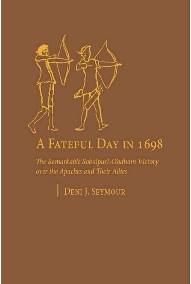 You can judge this book by its cover. The sketch of the O’odham archers on the cover of “A Fateful Day in 1698” is drawn by Father Kino and is copied from his famous 1695 map. Dr. Deni Seymour’s leading archaeological work & archival research gives voice to the almost forgotten Sobaipuri- O’odham people. One can understand Kino’s good fortune and “favores celestiales” in living and working with his beloved friends, the valiant and desert sharing O’odham people. Dr. Seymour’s next book with Tony Burrell & David Tenario is “Remembering Those Who’ve Lost Their Songs: A Collaborative Perspective on Heritage and Identity at San Xavier del Bac.”
You can judge this book by its cover. The sketch of the O’odham archers on the cover of “A Fateful Day in 1698” is drawn by Father Kino and is copied from his famous 1695 map. Dr. Deni Seymour’s leading archaeological work & archival research gives voice to the almost forgotten Sobaipuri- O’odham people. One can understand Kino’s good fortune and “favores celestiales” in living and working with his beloved friends, the valiant and desert sharing O’odham people. Dr. Seymour’s next book with Tony Burrell & David Tenario is “Remembering Those Who’ve Lost Their Songs: A Collaborative Perspective on Heritage and Identity at San Xavier del Bac.”
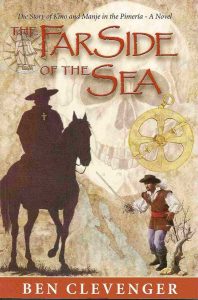 “The Far Side of the Sea“: The Story of Kino and Manje in the Pimería Alta” by Dr. Ben Clevenger, M.D. is both great story telling & history in the historical fiction gender. Clevenger masterfully interweaves the dangers of frontier life in the 1700s along with the great detective story about the archaeological discovery of Kino’s skeletal remains in the 1960s. Clevenger’s next book is about Lutheran theologian Dietrich Bonhoeffer and the man who lead the military coup to kill Hitler – another great story about the friendship between a man of God and a man of the world – each confronting in their own way the realities of violence and evil.
“The Far Side of the Sea“: The Story of Kino and Manje in the Pimería Alta” by Dr. Ben Clevenger, M.D. is both great story telling & history in the historical fiction gender. Clevenger masterfully interweaves the dangers of frontier life in the 1700s along with the great detective story about the archaeological discovery of Kino’s skeletal remains in the 1960s. Clevenger’s next book is about Lutheran theologian Dietrich Bonhoeffer and the man who lead the military coup to kill Hitler – another great story about the friendship between a man of God and a man of the world – each confronting in their own way the realities of violence and evil.
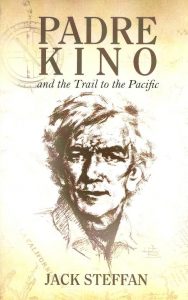 The best & most accessible book about Kino is “Padre Kino and the Trail to the Pacific” by Jacqueline Steffen (pen name – Jack Steffan). This illustrated page turning Kino account is in a historical fiction genre that is both great story telling & accurate history with nuance. Jacqueline captures the essential Kino through short chapter vignettes of key events in Kino’s 30 years of work in the Sonoran Desert as she also presents the differing view points of the Native People and Spanish colonists. For no charge read online or download in various formats at:
The best & most accessible book about Kino is “Padre Kino and the Trail to the Pacific” by Jacqueline Steffen (pen name – Jack Steffan). This illustrated page turning Kino account is in a historical fiction genre that is both great story telling & accurate history with nuance. Jacqueline captures the essential Kino through short chapter vignettes of key events in Kino’s 30 years of work in the Sonoran Desert as she also presents the differing view points of the Native People and Spanish colonists. For no charge read online or download in various formats at:
http://padrekino.com/kino-s-legacy/best-kino-book/.
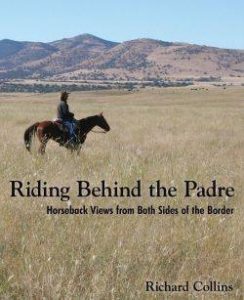 Our heroic Padre Kino is “the Padre” in the title of “Riding Behind the Padre: Horseback Views from Both Sides of the Border” This book written by rancher & conservationist Richard C. Collins is grand tour – past and present – of our beautiful borderlands. Dr. Bernard L. (Bunny) Fontana recommended Richard’s book for those who seek “a reasoned understanding of what’s taking place on both sides of the wall.” Richard is donating his author’s proceeds from his talks and the sale of the book to The Kino Border Initiative who are carrying on Kino’s legacy in assisting today’s migrants and advocating for humane borders.
Our heroic Padre Kino is “the Padre” in the title of “Riding Behind the Padre: Horseback Views from Both Sides of the Border” This book written by rancher & conservationist Richard C. Collins is grand tour – past and present – of our beautiful borderlands. Dr. Bernard L. (Bunny) Fontana recommended Richard’s book for those who seek “a reasoned understanding of what’s taking place on both sides of the wall.” Richard is donating his author’s proceeds from his talks and the sale of the book to The Kino Border Initiative who are carrying on Kino’s legacy in assisting today’s migrants and advocating for humane borders.


 Italiano
Italiano Español
Español Deutsch
Deutsch